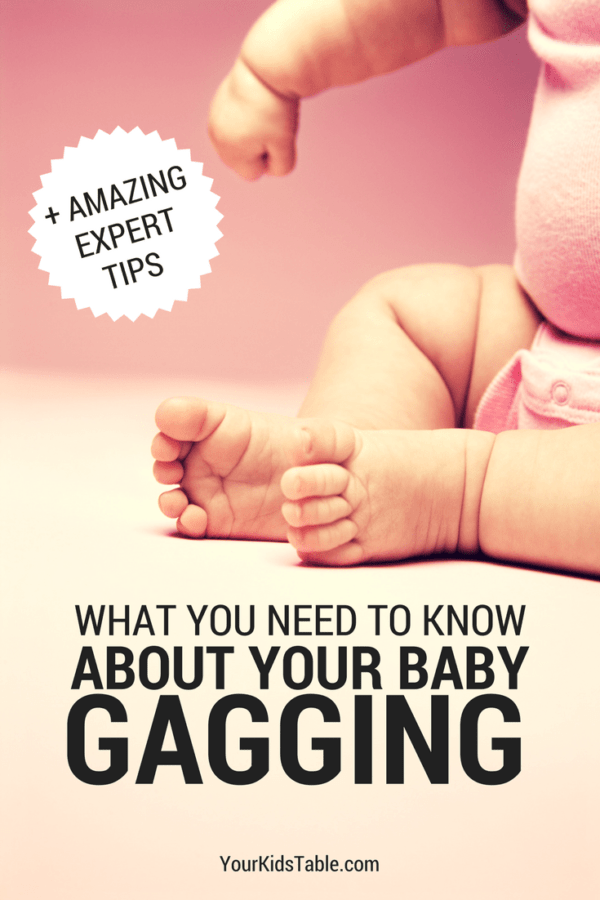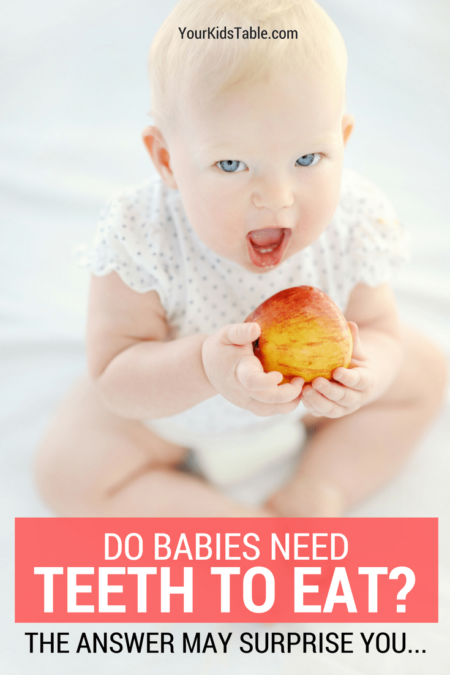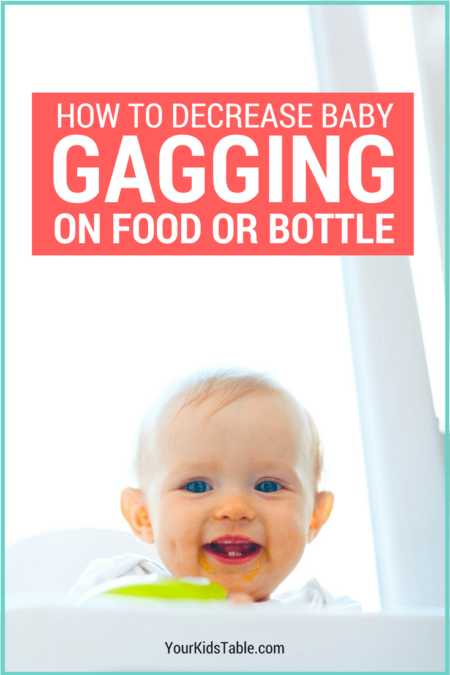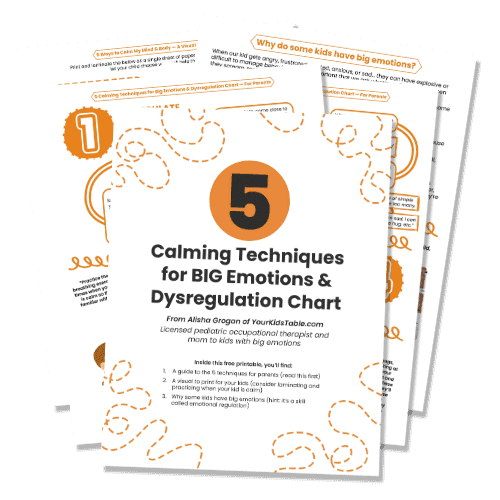Your baby gagging can be terrifying. Learn about the gag reflex in babies and what to do when babies have a sensitive reflex and gag on food or their bottle.
It’s a terrifying moment as a parent.
You know the one, because we’ve all been there, if only fleetingly.
It often happens as your baby is learning to eat.
They’ve taken a piece of food into their mouth, and we sit watching with big (sometimes fake) smiles on our face as if to offer encouragement. We watch closely, wondering if our little babe can pull off swallowing safely, and suddenly there’s a split second of silence. Their eyes pop out of their heads, they lunge forward, and they gag.
In that same split second, your heart is thumping so hard in your chest it feels like it’s going to bust through. You also leap forward, unsure of what you should even be doing. Your baby gags again and again. Something must be done, so you try to get that overcooked little piece of carrot out of their mouth. You succeed, collapsing into the chair, and pull the food away from your baby because, well, you need a second.
As you sit there, arms still twitching, as the adrenaline slowly dissipates, you wonder, “Is that normal?”
Or, as is the case for some babies, the baby gagging has become all too frequent, and you just don’t know how to stop it from happening.
That is just one of many instances that can play out in our homes with baby gagging. And, to be perfectly honest, sometimes it’s completely normal for a baby to gag as they’re learning to eat or on the nipple of their bottle.
And, sometimes it’s not.
To ease your fragile parent heart (I’ve got one too), we’re going to cover what the baby gag reflex is, when you need to worry about baby gagging, how to decrease baby gagging, and more! You’ll also find more tips in My Baby Won’t Eat Solids and How to Transition to Table Foods.
The Baby Gag Reflex
Believe it or not, babies are designed to gag on objects entering their mouth from the moment they come out of the womb. It’s a real reflex that’s there to protect them from actually choking on something, because as new infants, they have no skills to get an unexpected item out of their mouth.
This baby gag reflex is a very good thing.
When babies are first born, and for the first few months of life, this gag reflex is very sensitive and is triggered very easily. Meaning, something doesn’t have to get very far into a baby’s mouth to prompt the gag reflex and cause them to gag. (Find a total guide on Feeding Milestones.)
As they grow, get bigger, and start to put random objects into their mouth, their gag reflex moves further back in their mouth. The baby gag reflex becomes less sensitive, harder to elicit.
This is also a very good thing because it’s around the time babies learn to start eating real food. It would be very hard to eat if that gag reflex was still sensitive, which of course is the case some of the time…
A Sensitive Gag Reflex in Babies
Some babies seem to have a hyper-sensitive gag reflex, and this may be apparent very early on as bottles are introduced. You may be reading this right now because your baby consistently gags on a bottle.
This is even more likely for babies that are exclusively breastfed because they aren’t used to the feeling and texture of a bottle. The nipple may be bigger or go into their mouth further and trigger the baby gag reflex. Read tips here for getting a baby to take a bottle.
Other babies do just fine with bottles and nursing, but as in the example I started with, they frequently gag when trying to eat foods. Sometimes making it impossible for them to eat. This often occurs because the gag reflex is still too far forward in their mouth.
When Does Baby Gagging Occur
As I mentioned earlier, it is normal for all babies to gag sometimes. That gag reflex is present, and even if it isn’t that sensitive, you’re likely to see it happen on occasion. Let’s take a closer look at the times that will most likely be:
Baby Gags on Bottle
Some, not all, babies will gag when a bottle is put into their mouth because it goes a little too far back or the texture of the nipple feels a little different to them. Although it can be disconcerting, it’s typical behavior from an infant if it doesn’t happen all that often.
Baby Gags When Mouthing Toys
It’s even more common to see your baby gag when they are beginning to put teethers, various toys, and the keys they dug out of your purse into their mouth. They are literally desensitizing and moving that baby gag reflex further back into their mouth. Your baby is priming the pump for food usually weeks or months before they ever take a bite of food. (Read more about how to start feeding baby.)
Babies that chew on a lot of toys typically don’t have a sensitive gag reflex.
Baby Gagging on Food
Nearly all babies gag on food at some point. Eating is a highly coordinated event that we take for granted because it’s old hat.
Most babies will gag on foods because they are either too thick, as in the case with pureed baby food, and they have difficulty moving it back to swallow properly. Or, if they’re eating table foods, they may lose track of the food and it hits their gag reflex before they can get it in place to swallow correctly.
Again, this is a good thing, because if a piece of food haphazardly hits the back of the tongue and slides down their throat, there is a much higher likelihood that they could choke or aspirate on it (that’s when food goes into the lungs instead of the stomach, not a good thing). The gag helps project the food they lost track of out of their mouth, keeping them safe.
When baby gagging is excessive, there is likely one of two causes:
1.A baby’s ability to move their tongue and jaws around together to eat efficiently are called their oral motor skills. When their oral motor skills aren’t coordinated or the muscles like their tongue are weak, it’s very difficult to chew and swallow. If your baby gags AFTER trying to eat food, this is likely the cause. (Read more in oral motor exercises)
2. If a baby gags instantly after food touches their tongue, or perhaps just from looking at food, it’s a very good indicator that they are sensitive to the texture of the food. This is related to their sensory system and how their brain is understanding what the texture will feel like. (Read more in sensory issues with food)
Lastly, there is one factor that DOES NOT affect baby gagging on food, and that’s if your baby has teeth or not. It’s a popular misconception that babies need teeth to eat. They do not.
The first and only teeth that most babies typically have for months are their front teeth, which are not used for chewing. The front teeth are used to bite off pieces of larger foods, and most babies are eating small pieces of food.
But, even if your baby is taking bites off of food, their gums are strong enough to do the job.
Some babies won’t get any teeth until after their first birthday, waiting until then could lead to a whole host of feeding problems. The moral of this story is not to worry about your baby eating or gagging on food if they don’t have teeth yet.
If you’re concerned about when to give what foods, that’s a valid question and there are some guidelines to follow, which help decrease gagging. Check out When can babies eat cheerios to find the top foods that parents have questions about!
Grab a seat to learn about other feeding mistakes that parents are often told in my free online workshop. You’ll learn what to avoid so that your baby gets over gagging and on to eating table foods. I’ll send the link right to your inbox:
How to Respond to a Baby Gagging
It’s very easy to respond to your baby gagging with hysterics or even concern, because it’s scary. But, our response, even just once, can really leave an impression on a baby. At these early ages, our babies watch our reactions constantly and may learn from them. They can pick up on how we’re feeling and the last thing we want them to do is link the danger feeling they’re sensing as related to eating.
It can become ingrained in them quite quickly that eating is a bad thing, even though they aren’t able to articulate that.
When your baby does gag, appear calm and reassuring. Even act like its not a big deal. If you have to fake it, goodness knows I have many times, even slapping a smile on my face as I say, “You’re okay, would you like a drink?”
If your baby continues to gag on food in their mouth, then gently lean them forward. This will either help the food fall out of their mouth or bring the food to the front of their mouth, so they can swallow it safely.
If they still continue to gag, make a hook with your pinky finger and put in to one side of their mouth and sweep it to the other side, sweeping any food out. You may have to do this a few times.
I realize that I’ve probably just petrified you! If you’re feeling very nervous about your baby choking, it would be helpful to take an infant CPR class. You can also read more here.
Affiliate links used below. See our full disclosure.
How to Decrease Baby Gagging
Yes, there are actually some steps you can take to help decrease baby gagging!
For Baby Gagging on a Bottle:
You’ll want to try small nipples and experiment with different flows. Some babies may gag because the milk is taking too long to come out and others because it’s way too fast for them to manage.
Also, make sure baby is in a semi upright position and that their head isn’t tipped too far back. Put the nipple to their lips first and let them feel it for a second. Then, slowly put it into their mouth.
If the gagging still continues, use a pacifier or your pinky finger to rub on their gums and the sides of their tongue three to four times a day to help desensitize the sensitive gag reflex.
For Babies Gagging on Food:
Make sure they have tons of opportunities to chew on teethers, safe toys, and even large pieces of whole foods they can’t get pieces off of. Think about a whole raw carrot or stalk of celery (if they can get pieces of it off, most can’t, then don’t use it). If they don’t seem interested, demonstrate and show them. This two pronged teether is one of my favorites because it reaches just far enough into their mouth and really works at desensitizing.
I also love vibrating teethers, because they vibrate and give lots of sensory input when they bite down. I used this one with all my kids.
You can also brush your child’s teeth, or rather their gums, and the sides of their tongue. Allow them to hold and bite on the toothbrush. This is a perfect little toothbrush for babies. The teeth/gum brushing also works to desensitize the gag reflex, improve oral motor skills, and improve sensory processing!
Read more here on how to teach your baby to eat finger foods. These steps will also be helpful to decrease gagging.
When Do You Need to Worry About Baby Gagging
First of all, it’s very important to know that baby gagging is different than a baby choking. Choking means something is already in their throat and they can’t get it out. Gagging is something in their mouth, or even nothing in their mouth, if they are just put off by a texture of food.
Many of us gag when we smell something absolutely putrid, some babies and children do that with foods they aren’t familiar with or don’t prefer.
If your baby is gagging so much, it’s difficult to feed them and your legitimately concerned about their growth because they aren’t eating or drinking enough, I’d recommend getting a feeding evaluation. If you live in the states, you can get that free through early intervention, or you can seek out feeding therapy from other sources.
And, if you want to make the most out of mealtimes in your home as your baby grows, download the 9 Steps to Improve Eating, I’ll send it right to your inbox! These are my top tips for raising a child that has a healthy relationship for food. Get this free printable here!
Before I end, I wanted to give a big shout out to the folks at Feedspot for naming Your Kid’s Table one of the best kids food blogs on the web! You can check out the whole list here.
More on Baby Gagging
How to Transition to Table Foods
What to Do When Baby Won’t Eat Solids: 7 Simple Steps
Mega List of Table Foods for Your Baby or Toddler
Feeding Red Flags for Babies and Toddlers
Did you pin this?
Use the button below or scroll to any picture in this post, tap it, and you’ll see the pin it button appear! You can stick in your favorite board for safe keeping!
Alisha Grogan is a licensed occupational therapist and founder of Your Kid’s Table. She has over 14 years experience with expertise in sensory processing and feeding development in babies, toddlers, and children. Alisha also has 3 boys of her own at home. Learn more about her here.






Hello I currently look after an 8.5 month old who is gagging and vomiting on most foods, including smooth purees, yoghurt and baby cereals. The most she has managed is a couple of weaning spoons full of baby food. Or a melty puff or 2. She vomits frequently
And mum is still breastfeeding every 1.5 -2 hours. I am concerned but mum doesn’t seem bothered.
Is the gagging overfeeding or more likely sensory related ? What should I be advising ?
Hi Hazel,
This could be a range of things. It sounds like a possible food aversion or oral sensory issues. Could also be allergies, but that would have to be diagnosed by a doctor. I’d start with oral sensory work and see how that goes.
Best,
Laura
Your Kid’s Table team member
“If they still continue to gag, make a hook with your pinky finger and put in to one side of their mouth and sweep it to the other side, sweeping any food out. You may have to do this a few times.”
Would this not be considered a “blind sweep” and possibly push the offending piece of food farther into the airway–potentiating choking? CPR classes are quite explicit about never performing a “blind sweep”–i.e. attempting to remove material in the mouth with fingers whether you can see or not. I have been CPR/ACLS/PALS certified for over 15 years. I would not teach this.
Hey Lynette,
Thanks for your concerns and we understand where you are coming from! We are CPR certified here at Your Kids Table as well. What we are referring to is specifically a baby that is habitually gagging NOT choking, as that is the main difference here. Hope that helps to clarify!
Best,
Desiree
That may be true but you are talking to the general public who already have difficulty discerning between the two–or they would not be here on this site. No pediatrician I know would advise this to a new parent. It is an outdated and unsafe practice.
Heya!
My 8/9 month old has a sensitive gag reflex but it’s a strange one. She loves smooth purée, she chews and bites a lot on toys, dummy, bottle and my boob 😅 she will eat rice chips that dissolve quickly and noodles. But as soon as I feed her surprise lumpy food she gags A LOT, to the point she goes red and vomits everywhere. But she loves food and always wants our food, I can give her pea sized amounts of our food and she’ll eat it no problem i.e. cheese, dumplings, toast, egg, tomato, avocado, mince so all textures from slimy, soft and firm. Because she gags so much I’m so scared to give her finger food (bigger prices than a pea size) I feel like I’m holding her back. Like today I tried to make her porridge thicker and she gagged towards the end. We did have a scary choking incident a couple weeks back where she swiped a corn chip without us noticing and choked till blue and frothing at the mouth so that has set me back. Any tips would be much appreciated, I don’t want her miss out on learning to chew and cause bigger problems for her down the track. Thank you kindly! ☺️
Hey Annabell,
Thanks for reaching out! It sounds like you guys are right on track. So sorry to hear about the chip incident, it sounds like that was really scary! Mixed textures are actually the most challenging for babies to learn to eat. Even more challenging than a lot of table foods. This happens because it is so many different sensations in their mouths at once that they can’t quite figure out what to do with the food- that is when you see the gagging happen! We usually suggest adding those in after a lot of practice with other foods first. The dissolvable solids like graham crackers and Gerber puffs are great foods for first learning to chew. It can also be helpful to demonstrate with an over exaggerated chew. Definitely chew out our article on teaching to chew for some more suggestions!
Best,
Andrea
Question my son is about to be one and he only wants smooth baby food he won’t eat any thing with hunks in it nothing but baby food with rice cereal if I try and feed anything else he will gag what should I do
Hey Ashley!
Thanks so much for reaching out! We know how hard it can be to transition from baby food to table foods. First, I wouldn’t serve him baby food with chunks in it (while these are considered a Level 3 baby food, it’s not developmentally the next step, while some kids can manage, others need more help). The next step would be to start working on meltable foods such as “puffs”. You can learn more about the steps in our free workshop! Save your seat here!
Best,
Desiree
My baby is 11 months and he will eat baby food fine but will not eat any table food even if blended to the texture of baby foods. He gags and will not eat it. I’m worried what should I do
Hey Tracy,
That sounds like a challenge for you guys! The next step after baby foods is actually dissolvable solids like graham crackers or puffs, rather than stage 3 type foods. Our free table foods workshop would be the perfect place for you to get some more suggestions. You can save your seat HERE. Reach out with any questions!
Best,
Andrea
Hi,
My 17 mo will not eat anything. We’ve had feeding therapy since he was 4 mo and it was bc he was severely gagging, not taking enough milk, severe GERD and CMPA. We completed several cycles of feeding therapy with no progress. He still hates anything coming close to his mouth or even seeing a spoon, any utensil and seeing his bottle for longer than 2-3 secs before feeding him (like an infant). This gag leads to vomiting 99% of the time. He used to vomit up to 12 times a day until we found a good reflux medication. This worked until he finally dropped to only having 2-3 episodes a day and yet he will not eat anything. I’m so worn out and so very worried for him. He’s also very behind on milestones and his dehydration visits to the ER seems to lead to possible ASD, according to ER physicians, neurologist, & developmental pediatrics. They’ve tested him on so many occasions for everything & anything medically possible and nothing. They finally concluded it could be bc of ASD and want to redo every single test ti use for research nationally. They have not seen any case like him bc he continues to gain weight proportionally, even after barely starting to walk about a month ago (@ 16 mo). I cry almost every single night trying to figure out what to do. He also just started OT but they have yet to do anything with feeding. Their focus seems to be more about a possible ASD scenario. That feeding is not really a focus bc of his weight gain. Please help me or guide as far what else to do? I’ve read several of your reports and I’m only praying someone out there could please help me. I honestly don’t know what to do anymore, other than cry & simply have no progress whatsoever.
I kindly ask for any help please. Thank you so much for your time.
Give him stage 2 gerber
Hey Maria,
So happy you reached out, I’m glad you have found some of our articles! First if you aren’t already, I’d try to allow him to have play in different foods to see if he’s willing to play and touch these textures! Then I’d be working on him be accepting of you getting near his mouth, with your hands, stuffed animals, etc. This will help build rapport while no food is involved. We do have a free workshop that can be helpful for you if you are only utilizing purees you can save your seat Here. If he is able to chew some foods, like crackers or cheerios, anything then this workshop may be more appropriate. If you need help deciding which one you can reach out at hello@yourkidstable.com
Best,
Desiree
Hi!
My baby is 12 months old. We are trying thicker purées but sometimes he will gag and sometimes he will not. The instances that he does gag he no longer wants to continue to eat. The other thing is that he will not feed himself if the food in any way is sticky. So we are limited to puffs. Any suggestions would be helpful.
Hi Alyssa, This can be hard and we see it a lot!! I’d try some tips from the article. Also, try to be doing some food play outside of mealtimes to get him to touch and play to feel comfortable with the different textures (this is the first step to eating). Keep us posted!
Best,
Desiree
My baby 8 months an I can’t get her to eat baby food she had no interest! but anything off the table she wants . She doesn’t like baby food or melts im running out of options please help
Hi Nicole,
This transition can be a hard one. Take a breath 🙂 I’d try to get her interested in playing with the baby food to see if you can get her to touch it/play with hands. This is the first step to eating and can be helpful. Also, you can watch our free workshop on which foods to provide first and some tips to set up successful mealtimes! Save your seat here
Best,
Desiree
My son is just barely over 12 months old and his appetite is changing but in which way, I don’t know. He gets excited when I make soft food for him but then loses interest very quickly, then I offer him solid foods (trying to transition) and he ONLY wants to play with it. What do I do? I’m worried he isn’t getting enough to eat.
Hey Alina,
So sorry you are going through this, as we understand how difficult it can be to make this transition! I’d try to provide him some meltable foods ie: puffs, graham crackers, etc to see how he manages with those and modeling taking bites for him so he is able to model after you! We do walk you through this and some other strategies in our free workshop. You can save your seat HERE
Best,
Desiree
Hello,
My baby is 10 months almost 11, we had started puffs earlier and he had choked on a puff although they dissolve. It was a very scary time so we stopped all progress because well it was really scary. He has no problem eating the cheese doodles by Gerber but still doesn’t do well with the puffs. We also moved to potatoes, bananas. And he does fine. Today we tried macaroni noodle just a tiny piece and he started gagging. I’m unsure if it’s just me, I’m unsure where to go next to move on or what.
It’s not you Ashley, it sounds like he’s having some trouble figuring it all out. I want you to be cautious, but it’s also important to be proactive. Check out this post on transitioning your baby to table foods, there’s a step by step guide there that I think will be very helpful!
No it’s not just you and yes choking is scary !! This trend to start feeding babies as young as 6-8 mos old whole food cut in slices the size of your finger, even if steamed is distressing! It is not worth risking your child’s life to hurry and introduce whole foods before they are old enough and have teeth to chew and understand to eat slowly. My son choked and nearly died and he did have teeth and understood to eat slow. He was just shy of being 2 and choked on a chopped up hard boiled egg. He made no noise either. The white is rubbery and the throat forms to it making it extremely hard to dislodge- he was unconscious until just before paramedics arrived. After repeated attempts to dislodge the food he gasped and his eyes were rolled back in his head and head hanging and was drooling. His eyes still did not focus when oxygen was given. Finally after arriving at the hospital he became coherent and responding to me. Every precaution is worth your child’s life! Taking the time to mash or purée food may save your baby’s life, being incapable of handling unprepared solid food to early in life. It is worth the wait until oral motor skills are more developed.
Hi Kobi,
Thanks for sharing your experiences. That sounds extremely frightening. I’m so sorry you and your son had to go through that experience! It can happen to anyone and is such a scary thing. We always suggest supervision of eating for children and suggest parents talk to their doctor about possibly taking a CPR class if they have concerns. Your Kids Table recommends safe feeding practices such as safe seating and starting off with foods that were created especially for little ones to dissolve easily to build up chewing skills.
Best,
Andrea
Hi Andrea! And kids table team! So my situation is very different! My son doesn’t really gag on food or cause himself to vomit. But he actually before, and after meals, and at random times of the day, despite our positive progress with transitioning to solids, forces his finger into the back of his mouth almost like it’s natural to him. I mean we’re talking anytime he doesn’t have food, a bottle or a teething toy in his mouth, he gags himself with his finger until his face turns red and he obviously isn’t getting the satisfaction he needs because he does it again 30 seconds later or 10 seconds later. Have you seen any instances like this? If you’re even still with this chat I hope I hear back from you. !!!
Also, I cannot get him to open his mouth for me, of course, to let me look— nor will he let me feel with my finger whatsoever!!!
Hey Tori, This can be tricky and I’d for sure bring it up to his pediatrician. I’d try providing oral input in/around his mouth (I’d try vibrating toothbrush) to see if that is the input that he is seeking out. I’d also try to do proprioceptive activities, as those can be helpful when they are orally seeking input, to note if this has a difference as well! You can check out some proprioceptive activities here: https://yourkidstable.com/proprioceptive-activities/
Hello,
My son is seven months – the doctor just told me he has a sensitive gag reflex. He’s on stage two purées but anything thick like rice and lentil or peas and brown rice he gags. He does well with yogurt and any other stage 2 food all organs veggies, all greens, and mostly all fruits except maybe peach. I tried pastina soup right before seven months but didn’t do well. Do you think the sensitive gag reflex will getter better as he gets older. My daughter was on all table food by around nine months. With him i seem to be taking it slower.
It sounds like you’re off to a good start, but I’d definitely read how to transition to table foods, you have some time yet, but this will help explain what’s going on and what table foods to focus on first.
My baby girl is 12 months and gags on anything with texture (anything above stage 2 baby food, even she gags on apple stage 2). She If we give her the slightest texture (such as apple stage 2 or any stage 3), she will gag until she vomits every time. Should I be concerned at this age?
Allie, I’m going to be straight with you. At this age, I would get a feeding eval as soon as you can. You can find out more here about feeding therapy. You don’t need to panic because kids can get over this, but it can get worse if not addressed. I’d bring you dr in the loop too.
My daughter is 7 months old and I’ve been introducing her to solids over the past month or so. She seems interested in trying new foods, especially if she can hold it herself, like a puff or teething biscuit, or cracker. She is still getting the hang of chewing up and moving the food back to swallow, even with some of the puree. A lot of it falls out, or is pushed out if she isn’t a big fan of it. When she does go to swallow, she frequently coughs. Is the cough another presentation of the gag reflex? She doesn’t do it with the puree foods that she seems to like, such as apples, peaches, or pears. But for veggie purees and the crispy foods, she coughs just a little. And she doesn’t seem distressed or upset. I offer her a sip of water or 50/50 juice water in a cup, which she might or might not accept. I want to keep meal time pleasant for her while continuing to try veggies, but not put her at risk of chocking of course.
This is pretty normal for this age! I’d check with your doctor for sure, but they may want you to hold off on table foods for another month, just to be on the safe side.
My grandson has sensory issues, and has been diagnosed with SPD though, for the most part, feeding issues aren’t one of them for him. I began reading this article because his baby sister has something called Laryngo-malaysia. It took her mom dad and pediatrician more than year to figure it out, with the help of an Ear, Nose & Throat Specialist. I am just mentioning this in case there are parents out there searching for an answer to when a baby chokes often after they’ve been crying. If parents are searching for an answer to a baby choking after he or she has been crying they may want to read about Laryngo-malaysia.
My baby doesn’t chew on toys and she gags when eating puffs. Any suggestions?
Keep offering those toys to her. Try dipping them in baby food. Demonstrate for her. Try different ones! Also, did you see the link for “when babies don’t eat solids“?
Hi, have a 9 month old with a sensitive gag reflex..at the moment he’s doesn’t eat without distraction. I would really like to be cool and not pressure him but he hasn’t gained weight for over a month and I don’t know what else to do. He’s still mainly on formula and purees(not a lot) on good days
Hey Chelsea,
Always remember you are doing your best, so great job at getting him to eat! Have you tried having him play in a variety of foods outside of mealtimes? As well utilizing a tooth brush to help work on the gag reflex while brushing his teeth? Just some little suggestions. If you haven’t seen it yet, our free workshop would have some great tips for you as well. You can save your seat HERE
Best,
Desiree
Hi,
My baby is 6.5 months we’ve been introducing solids for about 3 weeks. We are trying the baby-led weaning method, although, I have also spoon fed some purees such as avocado, sweet potato, and quinoa cereal. I have also tried giving him soft foods that he can pick up such as banana, roasted sweet potato sticks, steamed carrot sticks… My baby seemed receptive to the mashed avocado and sweet potato purees at first, but has recently been gagging (and often spitting up) on just about anything I give him- both purees and pieces he picks up and attempts to self feed. The only thing he has not gagged on has been strawberry which I have cut into pieces he can hold and self feed. He really seems to love them. The other few foods I have tried, it almost seems like he barely tastes them or has any in his mouth and he begins gagging. Just wondering if you have any additional advice or if I should try different foods, since he does like strawberry (maybe it’s an easier texture for him)? Thank you for any help! I am hoping not to have to clean up spit up after every solid food feeding attempt!
Hey Olivia, I highly recommend two other posts on my site that I think will answer all your questions:
1. Pro and cons of BLW
2. Transitioning to table foods
Take a look at those and let me know if you have more questions!